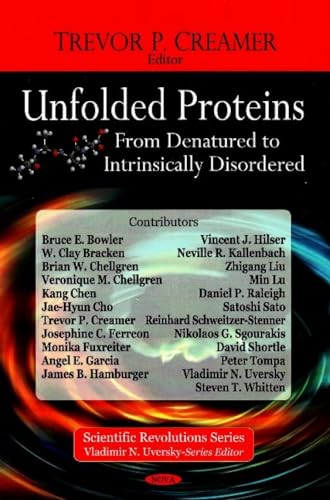Items related to Unfolded Proteins: From Denatured to Intrinsically...

The word revolution has a number of definitions (The American Heritage Dictionary, 2006). The one most pertinent to this series and volume is 'a sudden or momentous change in a situation'. Recent years have seen an unprecedented explosion of interest in unfolded proteins in all of their various forms. Coupled with this increase in interest we have seen momentous changes in the way unfolded proteins are viewed. Two particular paradigms have come under close scrutiny: unfolded proteins are disordered random coils devoid of persistent structure, and protein function first requires protein structure. The first of these is currently a hotly debated subject. The second paradigm we can safely claim has been overturned. There is a second definition of revolution that is quite relevant to a significant portion of the work reviewed herein, in particular those chapters dealing with local and persistent structure in unfolded proteins. That definition is 'a turning or rotational motion about an axis' (The American Heritage Dictionary, 2006). About four decades ago, Charles Tanford (1968) demonstrated that highly denatured proteins possess hydrodynamic properties consistent with Paul Flory's random coil (Flory, 1969). Given that the Flory random coil definition included the stipulation that conformers making up the denatured state ensemble would differ in energy by just a few kT, there has been the assumption that denatured states must therefore be completely random in nature with no persistent structure or biases towards particular conformers. Notably however, Tanford did note the random coil-like hydrodynamic data he obtained did not necessarily rule out the presence of structure in denatured proteins (Tanford, 1968). Around the same time, Sam Krimm and M. Lois Tiffany noted that the CD spectra they obtained for proteins in the presence of high concentration of chemical denaturants had similarities to spectra obtained for homopolymers of proline, lysine, and glutamic acid in water (Tiffany and Krimm, 1968a, 1968b, 1973, 1974). Homopolymers of these residues were known to adopt the left-handed polyproline II conformation, leading Tiffany and Krimm to hypothesise that highly denatured proteins possess significant polyproline II helix content. Of these two views, that espousing the lack of structure in denatured proteins became more widely adopted and was, over time, adopted as a central paradigm in protein folding. As several of the chapters in this volume note, a Tiffany and Krimm-like view appears to be, to some extent, the more correct one. The level to which it is correct is still unknown, although it is clear that the polyproline II helical conformation is not the only, perhaps not even the most common, persistent conformation present in unfolded proteins. Thus we have come through a full circle or revolution. (from the preface)
"synopsis" may belong to another edition of this title.
Product Description:
Defines revolution as 'a sudden or momentous change in a situation'.
"About this title" may belong to another edition of this title.
- PublisherNova Science Publishers Inc
- Publication date2008
- ISBN 10 1604561076
- ISBN 13 9781604561074
- BindingHardcover
- Number of pages785
(No Available Copies)
Search Books: Create a WantIf you know the book but cannot find it on AbeBooks, we can automatically search for it on your behalf as new inventory is added. If it is added to AbeBooks by one of our member booksellers, we will notify you!
Create a Want